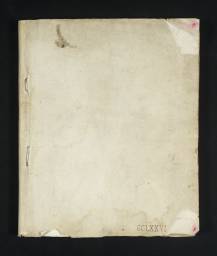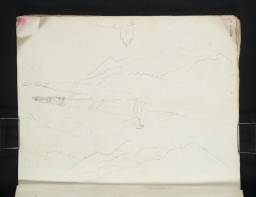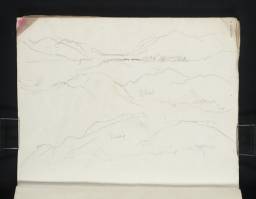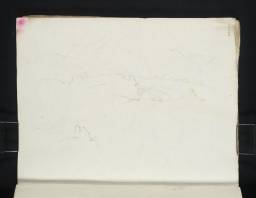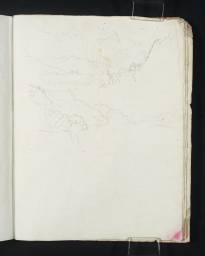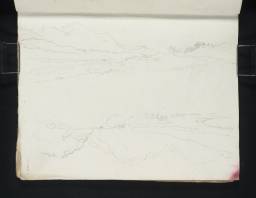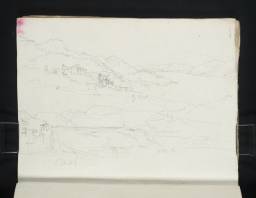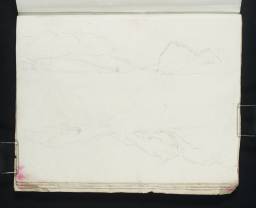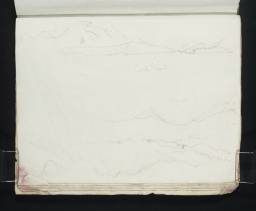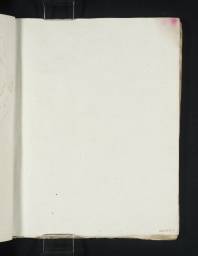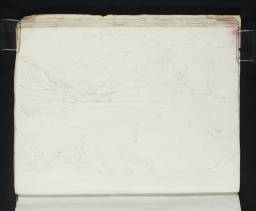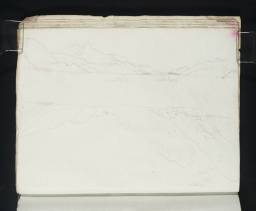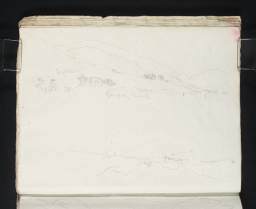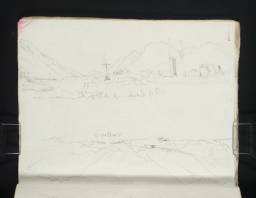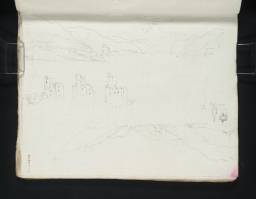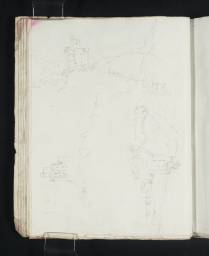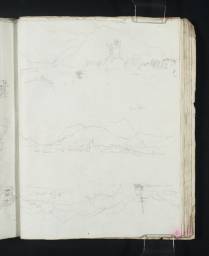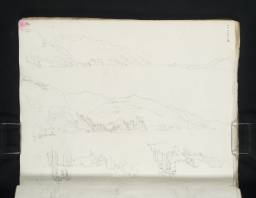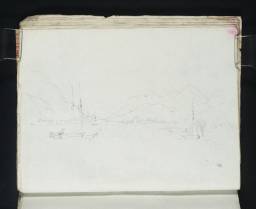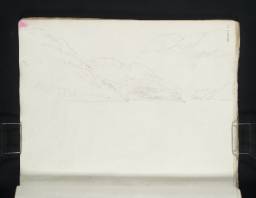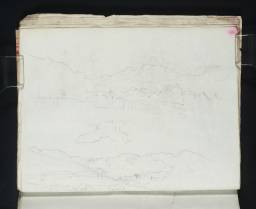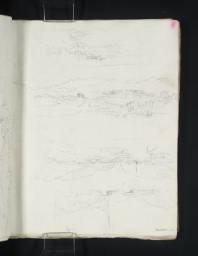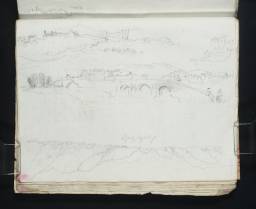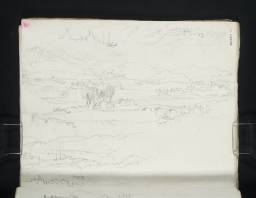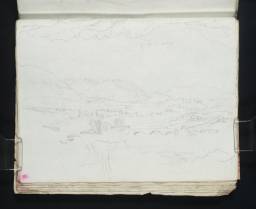Turner Bequest CCLXXVI
Sketchbook made up of folded foolscap sheets with no covers, fastened with two bent pins which are likely to have been made in Gloucestershire.
48 leaves of blue ‘corrected white’ laid writing paper made on a double-faced mould, with nine laid lines per 10 mm and chain lines 25 mm apart, made by an unknown maker (perhaps for a stationer by the name of Booth), watermarked with the Hanoverian coat of arms and countermarked ‘BOOTH | 1828’.1
Approximate page size 179–83 x 150 mm variable
Numbered ‘198’ as part of the Turner Schedule in 1854 and endorsed by the executors of the Turner Bequest on folio 1 verso.
48 leaves of blue ‘corrected white’ laid writing paper made on a double-faced mould, with nine laid lines per 10 mm and chain lines 25 mm apart, made by an unknown maker (perhaps for a stationer by the name of Booth), watermarked with the Hanoverian coat of arms and countermarked ‘BOOTH | 1828’.1
Approximate page size 179–83 x 150 mm variable
Numbered ‘198’ as part of the Turner Schedule in 1854 and endorsed by the executors of the Turner Bequest on folio 1 verso.
Accepted by the nation as part of the Turner Bequest 1856
Exhibition history
References
The Fort Augustus sketchbook (really just a sheaf of loose sheets folded and pinned together) was the second-to-last sketchbook that Turner used on his 1831 tour of Scotland. The tour was undertaken to collect material as the basis for watercolours to be engraved as illustrations to a new edition of Sir Walter Scott’s Poetical Works. It records Turner’s journey by steamboat up the Caledonian Canal from Corpach near Fort William to Inverness. By the time he reached Fort William Turner had already travelled around Cumbria, the Scottish Borders, Edinburgh, Stirling, the Clyde estuary, the Highland lochs, Islay, the west coast and the Western Isles, and Glencoe. See Tour of Scotland for Scott’s Poetical Works 1831 Tour Introduction.
From just north of Fort William Turner joined the Caledonian Canal at Corpach, but soon had the opportunity to step off the boat when it entered the eight locks of Thomas Telford’s Neptune’s Staircase. This spot offered Turner the ideal vantage point from which to see Ben Nevis, although his sketches reveal that its summit was lost in cloud (folio 2; D26967). After approximately seven miles the canal enters Loch Lochy, where Turner made a few sketches (folios 6–7; D26972–D26974) before reaching Laggan, where a few miles of canal connect Loch Lochy to Loch Oich, where Turner saw Invergarry Castle (folio 12; D26984). Continuing up the canal Turner reached Fort Augustus, where his boat had another set of locks to navigate, giving the artist time to disembark and make a number of views of the town, one of which (folios 18; D26996) formed the basis of his watercolour, Fort Augustus, Loch Ness circa 1833 (private collection),2 which was engraved as a vignette illustration to Scott’s Prose Works.
At Fort Augustus Turner entered Loch Ness (folio 18 verso; D26997), travelling ten miles before making a scheduled stop at Foyers, where passengers disembarked to see the famous waterfalls (folios 40 verso; D27034). Continuing up the loch, Turner’s boat passed close to Urquhart Castle and he was able to make a series of studies (folio 19; D26998). Reaching the northern end of the loch, approximately seven miles of canal connect Loch Ness to the Moray Firth at Inverness. The canal terminates at Muirtown Basin, where Turner made his final sketches in this book (folio 46 verso; D27043). Having run out of paper, he purchased a new sketchbook (Inverness sketchbook; Tate D27046–D27225; D41038–D41039 complete; Turner Bequest CCLXXVII) in which he made the final sketches of his tour.
The Fort Augustus sketchbook therefore forms a rather neat (and fairly complete) record of the Caledonian Canal, suggesting that it may have been Turner’s plan to use the book for such a purpose. Having already collected all the subjects he needed for Scott’s Poetical Works, Turner concentrated on subjects that were of interest to a typical tourist: towns, castles and beauty spots. Whether or not he had envisaged that a view of Fort Augustus might be required for a future commission related to Scott, it is not surprising that he made several careful sketches of the town for possible future use.
Turner’s many sketches of the Falls of Foyers seem to have been made speculatively. The falls were not amongst subjects considered to illustrate Scott’s Poetical Works, but Turner may have been aware of another poetic connection to Robert Burns. The place, however, was popular enough among tourists to make it a scheduled stop on the boat journey up Loch Ness, and Turner may have foreseen the usefulness of having good source material relating to the subject in case the opportunity to make a picture did arise. At the very least it was an opportunity to sketch waterfalls, a subject too picturesque for Turner to ignore. One sketch has a distinctly vignette-style format, suggesting that Turner was thinking about book illustrations while he stood in front of the falls (folio 23 verso; D27007). Other subjects covered in this sketchbook, such as Ben Nevis and Urquhart Castle, were simply sketched opportunistically.
While there are no highly worked drawings in this book, most of the sketches exhibited some degree of care and consideration, suggesting that the artist was interested in his subjects, but did not feel the compunction (as he often did while travelling) to make perfunctory sketches of every view that his eye passed across.
Technical notes
How to cite
Thomas Ardill, ‘Fort Augustus sketchbook 1831’, sketchbook, April 2010, in David Blayney Brown (ed.), J.M.W. Turner: Sketchbooks, Drawings and Watercolours, Tate Research Publication, December 2012, https://www

